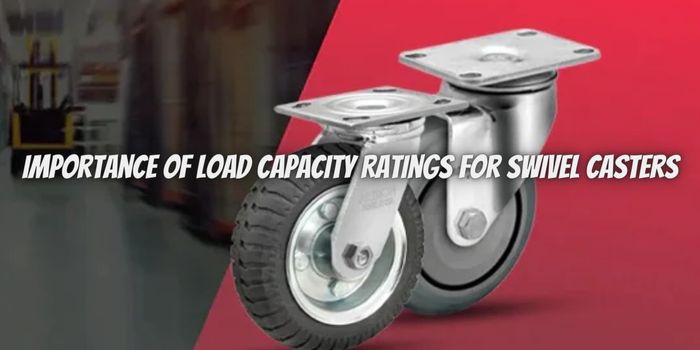In today’s fast-paced industrial and commercial operations world, efficiency and reliability are paramount. Every component, no matter how small, plays a crucial role in the smooth functioning of a system. Swivel casters, those seemingly unassuming wheels mounted on a pivoting frame, are no exception. These small yet mighty components significantly impact the mobility, safety, and longevity of equipment. Here, we will get deep into the world of swivel casters and explore the critical importance of load capacity ratings.
What are Swivel Casters?
Swivel casters are a kind of rotary-wheeled contraption regularly employed for material transportation and handling. Composed of a caster frame with an affixed revolving wheel, which is generally made from sturdy materials such as metal or plastic, the wheel is crafted to facilitate unrestricted 360-degree rotation and be firmly fixed when needed. Swivel casters are frequently employed to relocate furniture, equipment, and bulky items in professional and residential settings. They can be installed in medical facilities, offices, retail outlets, and numerous other commercial establishments.
Importance of Load Capacity Ratings
-
Ensuring Equipment Safety:
With safety front and center, the importance of adhering to load capacity ratings cannot be overstated. Overburdening swivel casters can have devastating consequences imagine a catastrophic breakdown resulting from an overloaded cart, likely causing significant personnel injury, product damage, or costly downtime. By understanding their limits and keeping loads within the stated specifications, operators can safeguard against such disasters and promote a secure work environment.
-
Prolonging Caster Lifespan:
Load capacity ratings also play a vital role in the longevity of swivel casters. When casters are consistently overloaded, they experience excessive wear and tear. This not only shortens their lifespan but also increases maintenance costs. By using swivel casters with load capacity ratings that match your equipment’s weight requirements, you can significantly extend their lifespan, reducing the need for replacements and maintenance.
-
Maintaining Equipment Efficiency:
Efficiency is the cornerstone of any successful operation. Equipment moves smoothly and effortlessly when swivel casters are appropriately matched to the load they carry. This enhances overall efficiency and productivity. Conversely, if casters are overloaded, they can become difficult to maneuver, slowing down processes and causing frustration among workers.
How to Select the Right Swivel Caster
Now that we understand the importance of load capacity ratings, let’s discuss selecting the right swivel caster for your specific needs.
-
Calculate Your Load:
Calculating your load is the best way to guarantee your equipment’s safe and efficient operation. Accurately ascertain the total weight of the cargo and unit combined, then select swivel casters with a higher load rating than the figure you have arrived at. An informed decision here will afford you much-needed peace of mind, knowing that you have equipped your gear as best suits its purpose. With the right preparation, you can be confident that no obstacle is too significant for your machine to overcome.
-
Consider Your Environment:
Different environments have different caster requirements. For example, if your equipment operates in wet or corrosive environments, you’ll need casters with rust-resistant materials. Consider factors like floor surfaces, temperature variations, and exposure to chemicals when selecting swivel casters.
-
Consult with Experts:
When it comes to caster selection, it pays to tap into the expertise of specialists. Leveraging their insight can prove invaluable in helping you make wise decisions, guaranteeing your equipment’s secure and productive performance. Knowledgeable guidance and clever counsel can make all the difference in steering you toward selecting optimal casters for your setup.
-
Think About Swivel Radius and Locking Mechanisms:
The swivel radius of the caster refers to the range of motion the wheel can achieve when the caster is rotated. A caster with a smaller swivel radius may be more suitable in tight spaces or applications requiring precise maneuverability. On the other hand, applications that require stability during movement might benefit from casters with a limited swivel range or locking mechanisms that can immobilize the swivel.
-
Consider Ergonomics and Noise:
Ergonomics and noise reduction are essential considerations in certain applications, especially those involving manual pushing or pulling of equipment. Some swivel casters have ergonomic features, such as easier swiveling or reduced rolling resistance, to minimize the effort required to move heavy loads. Additionally, casters with noise-reducing features, like soft treads or precision bearings, can contribute to a quieter work environment.
In conclusion, the importance of load capacity ratings for swivel casters cannot be overstated. These ratings are the foundation of safe, efficient, and reliable equipment operation. Understanding your equipment’s load requirements and selecting the appropriate swivel casters can enhance workplace safety, extend caster lifespan, and improve overall operational efficiency. Selecting the right high-quality swivel plate caster is paramount to ensuring your equipment’s safety, efficiency, and longevity.
